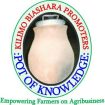Kenya’s agricultural landscape is diverse, with various crops adapted to its varied climates and soils. Among these, wheat stands out as a significant crop with both economic and food security implications. Despite the country’s rich history of growing staple crops like maize, wheat farming in Kenya is increasingly vital for meeting the demands of a growing population and ensuring food stability.
The Importance of Wheat in Kenya
Wheat is a staple food in Kenya, used in a variety of products from bread and chapati to cakes and pastries. As the Kenyan population grows and urbanizes, the demand for wheat-based products continues to rise. Despite being a relatively new addition to Kenya’s agricultural portfolio, wheat has become crucial in ensuring food diversity and security.
Geographical and Climatic Conditions
Wheat cultivation in Kenya is primarily concentrated in the highland areas, where the climatic conditions are most favorable. Regions such as the Rift Valley, parts of Central Kenya, and some areas of Eastern Kenya provide the cooler temperatures and well-drained soils needed for successful wheat farming. These areas benefit from a moderate climate with adequate rainfall, although irrigation is sometimes necessary to supplement natural precipitation.
Challenges in Wheat Farming
Wheat farming in Kenya is not without its challenges. Some of the major issues include:
- Pest and Disease Management: Wheat crops in Kenya are susceptible to various pests and diseases, such as the wheat stem rust and aphids. Effective management practices and disease-resistant varieties are essential to maintaining healthy crops.
- Soil Fertility: Maintaining soil fertility is crucial for optimal wheat yields. Farmers often face challenges related to soil degradation and nutrient depletion, which can impact productivity.
- Water Availability: While some wheat-growing regions benefit from sufficient rainfall, others rely heavily on irrigation. Water management practices are therefore critical to ensure consistent crop growth.
- Market Access and Price Volatility: Farmers may struggle with fluctuating market prices and access to markets. Improving infrastructure and market systems can help stabilize prices and ensure fair returns for farmers.
Advancements and Innovations
To address these challenges, various advancements and innovations are being introduced to improve wheat farming in Kenya:
- Improved Varieties: Agricultural research institutions are developing and promoting high-yielding, disease-resistant wheat varieties tailored to Kenya’s diverse climates. These varieties help farmers achieve better yields and reduce losses.
- Modern Farming Techniques: Adoption of modern farming techniques, such as precision farming and conservation tillage, is becoming more common. These practices enhance soil health, optimize water use, and increase productivity.
- Extension Services and Training: Agricultural extension services provide farmers with the knowledge and skills needed to manage their crops effectively. Training programs cover topics such as pest management, soil fertility, and efficient irrigation practices.
- Irrigation Solutions: Innovations in irrigation technology, such as drip irrigation and rainwater harvesting, are helping farmers manage water resources more efficiently and ensure consistent crop growth.
The Role of Government and Policy
The Kenyan government plays a crucial role in supporting wheat farming through various policies and initiatives. Programs aimed at improving seed access, providing subsidies for inputs, and investing in infrastructure are essential for the growth of the wheat sector. Additionally, efforts to promote research and development in agriculture help drive innovation and address the challenges faced by wheat farmers.
Looking Ahead
The future of wheat farming in Kenya holds promise, provided that the sector continues to adapt to changing conditions and leverage new technologies. With ongoing research, improved practices, and supportive policies, Kenya has the potential to enhance its wheat production and contribute to national food security.
As Kenya navigates the complexities of wheat farming, it is essential to focus on sustainable practices that ensure long-term productivity and environmental health. By addressing challenges and embracing innovations, Kenya can build a resilient and thriving wheat sector that meets the needs of its growing population.
In summary, wheat farming in Kenya is a dynamic and evolving field with significant implications for the country’s food security and agricultural economy. With continued support and investment, Kenya can cultivate a robust wheat industry that benefits both farmers and consumers alike.



